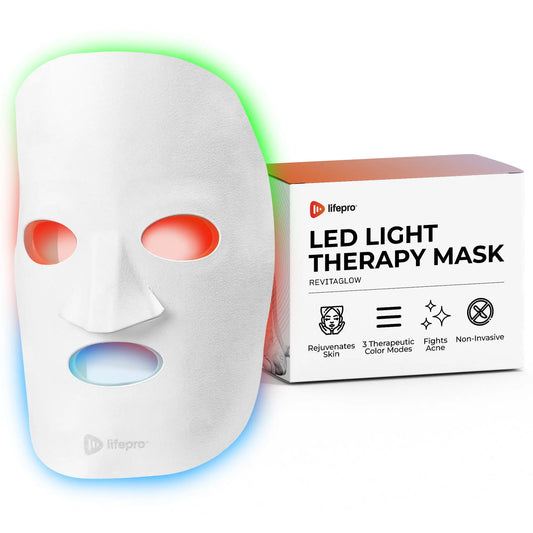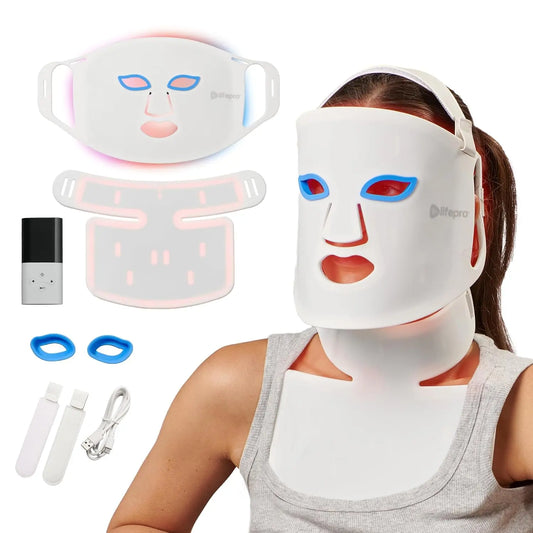In the quest for youthful and radiant skin, many people turn to various skincare treatments and technologies. One such technology that has gained popularity in recent years is LED light therapy, specifically in the form of LED light masks. These masks, also known as red light masks or LED face masks, are designed to emit specific wavelengths of light onto the skin to promote various skincare benefits.
But do these red light masks really work? Are they safe to use? What are the advantages and disadvantages of LED therapy masks? In this comprehensive article, we will delve into the world of LED light masks, explaining how they work, their potential benefits, and the science behind their effectiveness. So, let's shed some light on red light therapy and discover the truth behind LED light masks.
What Are LED Light Masks?
LED light masks are skincare devices that utilize light-emitting diodes (LEDs) to deliver targeted wavelengths of light to the skin.1 These masks are typically made of a flexible material that can be worn comfortably on the face, covering areas such as the forehead, cheeks, and chin.
LED light therapy masks come in various designs and configurations, but they all share a common goal: to harness the power of light to promote skin health and address specific skin concerns. These masks emit different colors of light, including red, blue, green, and yellow, each with its own unique benefits. However, for the purpose of this article, we will primarily focus on red light masks and their efficacy.

Do LED Light Masks Really Work?
The effectiveness of LED light masks, particularly red light masks, has been a subject of scientific research and clinical studies. While individual experiences may vary, there is evidence to suggest that LED light therapy can indeed provide benefits for the skin. Let's explore some of the key findings from research studies:
Stimulating Collagen Production
One of the main benefits of red light therapy is its ability to stimulate collagen production in the skin, which is particularly crucial for maintaining the health and resilience of sensitive skin. Collagen is a protein that plays a crucial role in maintaining the skin's structure, elasticity, and firmness. As we age, collagen production naturally declines, leading to the appearance of wrinkles and sagging skin.
Several studies have shown that red light therapy can promote collagen synthesis in the skin, helping to improve skin texture and reduce the appearance of fine lines and wrinkles. Learn more about red light therapy for wrinkles in our blog. A study published in the journal Photomedicine and Laser Surgery found that participants who received red light therapy experienced significant improvements in skin elasticity and a reduction in wrinkle depth.4
Enhancing Skin Healing and Repair
Another important aspect of LED therapy is its ability to enhance the healing and repair processes of the skin. Red light therapy has been shown to increase blood circulation, which can improve the delivery of oxygen and nutrients to the skin cells, aiding in the healing of wounds, scars, and other skin conditions.4 Red light therapy for cold sores has also shown promising results.
A study published in the Journal of Clinical and Aesthetic Dermatology demonstrated that LED light therapy, specifically red light therapy, can accelerate the healing of surgical wounds. The researchers found that participants who received red light therapy experienced faster wound closure and reduced inflammation compared to those who did not receive the treatment.4
Reducing Inflammation and Acne
Red light therapy for acne has also shown promise in reducing inflammation and treating it efficiently. Acne is a common skin condition characterized by the presence of pimples, blackheads, and whiteheads, often accompanied by redness and inflammation.
Research suggests that red light therapy can help reduce acne-related inflammation by targeting the sebaceous glands in the skin. These glands produce sebum, an oily substance that can clog pores and contribute to the development of acne.7 By inhibiting the production of excess sebum and reducing inflammation, red light therapy can help improve acne symptoms.
A study published in the Journal of Cosmetic and Laser Therapy found that participants who received LED light therapy experienced a significant reduction in acne lesions and inflammation. The researchers concluded that LED light therapy, in combination with other acne treatments, can be an effective approach for managing acne.5
How Do LED Light Masks Work?
To understand how LED light masks work, we need to delve into the science behind photobiomodulation, the process by which light energy interacts with cells and tissues in the body.
Photobiomodulation: The Science Behind LED Light Therapy
Photobiomodulation is a non-thermal process by which specific wavelengths of light are absorbed by cells, triggering a cascade of physiological responses. When applied to the skin, red light in the range of 600-700 nanometers (nm) can penetrate the epidermis and dermis, reaching the underlying skin cells.4
The absorbed red light energy stimulates various cellular processes, including the enhancement of mitochondrial Adenosine Triphosphate (ATP) production, cell signaling and growth factor synthesis, and the reduction of oxidative stress.4 These processes can contribute to the rejuvenation and healing of the skin, as well as the improvement of various skin concerns.
The Role of Different Wavelengths in LED Light Therapy
LED light masks emit different wavelengths of light, each with its own unique effects on the skin. While red light therapy is the focus of this article, it's worth mentioning the benefits of other colors commonly used in LED light therapy for various skin issues:
- Blue Light: Blue light therapy has been shown to have antibacterial properties and can help kill acne-causing bacteria on the skin. It is often used in the treatment of acne vulgaris.
- Green Light: Green light therapy is believed to help reduce hyperpigmentation and improve skin tone. It can also have a calming and soothing effect on the skin.
- Yellow Light: Yellow light therapy can help reduce redness and inflammation in the skin. It is often used in the treatment of rosacea and other inflammatory skin conditions.
- Infrared Light: Infrared light therapy, also known as near-infrared (NIR) therapy, penetrates deeper into the skin and can help promote wound healing, reduce pain, and improve overall skin health.
While each color of light has its specific benefits, red light therapy is particularly well-known for its rejuvenating effects on the skin. Now, let's explore the advantages and disadvantages of LED light therapy masks.
Are LED Light Masks Safe to Use?
When used as directed, LED light masks are generally considered safe for home use. LED light therapy has been extensively studied and has a favorable safety profile, with minimal side effects reported.
LED masks emit low levels of light energy, making them non-invasive and non-thermal. Unlike some other skincare treatments, such as laser therapy or chemical peels, LED light therapy does not cause damage to the skin's surface or require downtime for recovery.1
However, it's important to follow the instructions provided by the manufacturer and consult with a healthcare professional if you have any underlying skin conditions or concerns. If you experience any adverse reactions or discomfort while using an LED light mask, discontinue use and seek medical advice.1
What Are the Disadvantages of LED Light Therapy Masks?
While LED light therapy masks offer numerous benefits for the skin, it's important to consider their limitations and potential drawbacks. Here are some of the disadvantages to keep in mind:
- Time Commitment: LED light therapy masks typically require multiple sessions over an extended period for optimal results. Depending on the specific device and treatment protocol, you may need to use the mask for several weeks or months to see noticeable improvements in your skin.
- Limited Coverage: LED light masks may not provide full coverage for all areas of the face and neck. Some masks only cover specific regions, such as the forehead, cheeks, and chin, while leaving other areas untreated. This can limit the overall effectiveness of the treatment.
- Individual Variations: The results and effectiveness of LED light therapy can vary from person to person. Factors such as skin type, age, and the severity of the skin concern can influence the outcomes. It's important to manage expectations and understand that results may not be the same for everyone.
- Maintenance and Replacement: LED light masks typically have a limited lifespan for their LED bulbs. Over time, the bulbs may lose their effectiveness, requiring replacement or repair. It's important to consider the cost and availability of replacement parts or services when investing in an LED light mask.
- Not a Standalone Solution: LED light therapy masks are not a magical cure-all for all skin concerns. While they can provide significant benefits, they should be used as part of a comprehensive skincare routine that includes cleansing, moisturizing, and other appropriate treatments for your specific skin concerns.
- Safety Considerations: While LED light therapy is generally safe, it's important to use caution and follow the manufacturer's instructions. Avoid looking directly into the LED lights and protect your eyes with the provided eyewear.
If you’re still unconvinced if LED face masks are safe for your eyes, or if you have any underlying health conditions or are pregnant, it's recommended to consult with a healthcare professional before using an LED light mask.
Discover LED Light Therapy Masks from Lifepro
In conclusion, red light therapy devices, particularly red light masks, can be effective tools for improving the health and appearance of the skin. The science behind LED light therapy, known as photobiomodulation, supports its ability to stimulate collagen production, promote skin healing, reduce inflammation, and address various skin concerns.2
While individual results may vary, LED light therapy masks offer a non-invasive, safe, and convenient solution for those seeking to enhance their skincare routine and address specific skin concerns. However, it's important to manage expectations, understand the limitations of LED light therapy, and incorporate it as part of a comprehensive skincare regimen.
As with any skincare treatment, it's advisable to consult with a skincare professional or dermatologist to determine the best approach for your skin concerns and to ensure proper usage and safety. With the right knowledge, guidance, and consistency, LED light masks can be valuable allies in your journey to healthier, more radiant skin. So, why not give them a try and see the potential benefits for yourself?
Disclaimer: The information provided in this article is for informational purposes only and should not be considered as medical advice. Always consult with a qualified healthcare professional or dermatologist for personalized recommendations and guidance regarding your skincare concerns.
References:
- Ablon G. Phototherapy with Light Emitting Diodes: Treating a Broad Range of Medical and Aesthetic Conditions in Dermatology. J Clin Aesthet Dermatol. 2018;11(2):21-27.
- Wunsch A, Matuschka K. A controlled trial to determine the efficacy of red and near-infrared light treatment in patient satisfaction, reduction of fine lines, wrinkles, skin roughness, and intradermal collagen density increase. Photomed Laser Surg. 2014;32(2):93-100. doi:10.1089/pho.2013.3616
- Hong JH, Kim DY, Kye YC, Seo SH, Kim DH, Ahn HH. Lightening Effect of a Light-Emitting Diode Mask on Facial Skin: A Colorimetric Assessment. Ann Dermatol. 2019;31(2):247-248. doi:10.5021/ad.2019.31.2.247
- Couturaud V, Le Fur M, Pelletier M, Granotier F. Reverse skin aging signs by red light photobiomodulation. Skin Res Technol. 2023;29(7):e13391. doi:10.1111/srt.13391
- Ng JNC, Wanitphakdeedecha R, Yan C. Efficacy of home-use light-emitting diode device at 637 and 854-nm for facial rejuvenation: A split-face pilot study. J Cosmet Dermatol. 2020;19(9):2288-2294. doi:10.1111/jocd.13613
- Chaves ME, Araújo AR, Piancastelli AC, Pinotti M. Effects of low-power light therapy on wound healing: LASER x LED. An Bras Dermatol. 2014;89(4):616-623. doi:10.1590/abd1806-4841.20142519
- Pei S, Inamadar AC, Adya KA, Tsoukas MM. Light-based therapies in acne treatment. Indian Dermatol Online J. 2015;6(3):145-157. doi:10.4103/2229-5178.156379

RevitaGlow™ Light Therapy Mask

RevitaGlow Pro Light Therapy Mask
- Choosing a selection results in a full page refresh.
- Opens in a new window.


